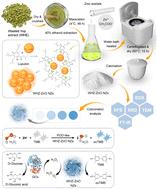Our official English website, www.x-mol.net, welcomes your feedback! (Note: you will need to create a separate account there.)
Facile green synthesis of wasted hop-based zinc oxide nanozymes as peroxidase-like catalysts for colorimetric analysis
Nanoscale ( IF 5.8 ) Pub Date : 2023-11-30 , DOI: 10.1039/d3nr04336c Pei Liu 1, 2 , Mengdi Liang 1, 2 , Zhengwei Liu 1, 2 , Haiyu Long 1, 2 , Han Cheng 1, 2 , Jiahe Su 1, 2 , Zhongbiao Tan 1 , Xuewen He 3 , Min Sun 4 , Xiangqian Li 1, 2 , Shuai He 1, 2
Nanoscale ( IF 5.8 ) Pub Date : 2023-11-30 , DOI: 10.1039/d3nr04336c Pei Liu 1, 2 , Mengdi Liang 1, 2 , Zhengwei Liu 1, 2 , Haiyu Long 1, 2 , Han Cheng 1, 2 , Jiahe Su 1, 2 , Zhongbiao Tan 1 , Xuewen He 3 , Min Sun 4 , Xiangqian Li 1, 2 , Shuai He 1, 2
Affiliation

|
Hops are a common ingredient in beer production, and a considerable quantity of hops is usually discarded as a waste material once the brewing process is completed. Transforming this waste material into valuable nanomaterials offers a sustainable approach that has the potential to significantly mitigate environmental impact. Herein, a facile and green protocol for the production of zinc oxide nanozymes (ZnO NZs) using wasted hop extract (WHE) as a natural precursor was demonstrated. The process involved a hydrothermal synthesis method followed by a calcination step to form the final ZnO NZs. The results revealed that lupulon, the main β-acid in hops, particularly the phenolic hydroxy group, is primarily responsible for the biosynthesis of ZnO NZs. The WHE-ZnO NZs exhibited exceptional peroxidase-like (POD-like) activity and served as effective catalysts for the oxidation of 3,3,5,5-tetramethylbenzidine (TMB) in the presence of hydrogen peroxide (H2O2). Analysis of the catalytic mechanism revealed that the POD-like activity of these WHE-ZnO NZs originated from their ability to expedite the transfer of electrons between TMB and H2O2, resulting in the enzymatic kinetics following the standard Michaelis–Menten mechanism. Furthermore, we developed a straightforward and user-friendly colorimetric technique for detecting both H2O2 and glucose. By utilizing the WHE-ZnO NZs as POD-like catalysts, we achieved a linear detection range of 1–1000 μM and a limit of detection of 0.24 μM (S/N = 3) for H2O2 detection and a linear range of 0–100 mM and a detection limit of 16.73 μM (S/N = 3) for glucose detection. These results highlighted the potential applications of our waste-to-resource approach for nanozyme synthesis in the field of analytical chemistry.
中文翻译:

轻松绿色合成废弃啤酒花基氧化锌纳米酶作为用于比色分析的过氧化物酶类催化剂
啤酒花是啤酒生产中的常见成分,一旦酿造过程完成,相当数量的啤酒花通常会作为废料被丢弃。将这种废料转化为有价值的纳米材料提供了一种可持续的方法,有可能显着减轻对环境的影响。在此,展示了一种使用废弃啤酒花提取物(WHE)作为天然前体生产氧化锌纳米酶(ZnO NZ)的简便且绿色的方案。该过程涉及水热合成方法,然后进行煅烧步骤以形成最终的 ZnO NZ。结果表明,蛇麻草中的主要β-酸,特别是酚羟基,主要负责ZnO NZs的生物合成。 WHE-ZnO NZs 表现出优异的类过氧化物酶(POD 类)活性,可作为过氧化氢(H 2 O 2 )存在下氧化 3,3,5,5-四甲基联苯胺(TMB)的有效催化剂。催化机制分析表明,这些 WHE-ZnO NZ 的 POD 样活性源于它们加速 TMB 和 H 2 O 2之间电子转移的能力,从而产生遵循标准 Michaelis-Menten 机制的酶动力学。此外,我们开发了一种简单且用户友好的比色技术,用于检测 H 2 O 2和葡萄糖。通过利用 WHE-ZnO NZs 作为 POD 类催化剂,我们实现了 1–1000 μM 的线性检测范围和 0 的检测限。H 2 O 2检测的线性范围为 24 μM (S/N = 3),葡萄糖检测的线性范围为 0–100 mM,检测限为 16.73 μM (S/N = 3)。这些结果凸显了我们的纳米酶合成废物资源化方法在分析化学领域的潜在应用。
更新日期:2023-11-30
中文翻译:

轻松绿色合成废弃啤酒花基氧化锌纳米酶作为用于比色分析的过氧化物酶类催化剂
啤酒花是啤酒生产中的常见成分,一旦酿造过程完成,相当数量的啤酒花通常会作为废料被丢弃。将这种废料转化为有价值的纳米材料提供了一种可持续的方法,有可能显着减轻对环境的影响。在此,展示了一种使用废弃啤酒花提取物(WHE)作为天然前体生产氧化锌纳米酶(ZnO NZ)的简便且绿色的方案。该过程涉及水热合成方法,然后进行煅烧步骤以形成最终的 ZnO NZ。结果表明,蛇麻草中的主要β-酸,特别是酚羟基,主要负责ZnO NZs的生物合成。 WHE-ZnO NZs 表现出优异的类过氧化物酶(POD 类)活性,可作为过氧化氢(H 2 O 2 )存在下氧化 3,3,5,5-四甲基联苯胺(TMB)的有效催化剂。催化机制分析表明,这些 WHE-ZnO NZ 的 POD 样活性源于它们加速 TMB 和 H 2 O 2之间电子转移的能力,从而产生遵循标准 Michaelis-Menten 机制的酶动力学。此外,我们开发了一种简单且用户友好的比色技术,用于检测 H 2 O 2和葡萄糖。通过利用 WHE-ZnO NZs 作为 POD 类催化剂,我们实现了 1–1000 μM 的线性检测范围和 0 的检测限。H 2 O 2检测的线性范围为 24 μM (S/N = 3),葡萄糖检测的线性范围为 0–100 mM,检测限为 16.73 μM (S/N = 3)。这些结果凸显了我们的纳米酶合成废物资源化方法在分析化学领域的潜在应用。















































 京公网安备 11010802027423号
京公网安备 11010802027423号